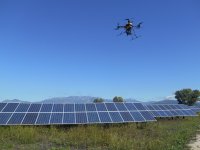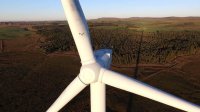Amazon caused quite the stir in 2013 when it announced plans to launch a drone delivery service. People were both thrilled and horrified at the thought of flying robots delivering toilet paper to our doorsteps.
Some drone enthusiasts hoped to see Amazon launch a drone-based solar installation service -- but alas, that business doesn't exist. Yet.
Drones are already disrupting the solar sector, however.

This week at Intersolar North America, DroneDeploy, a cloud software platform provider for commercial drones, and DJI, a leading maker of drones and camera technology, announced a partnership that is expected to dramatically increase the efficiency of solar panel installation and inspection using drone-based thermal imagery capture and analytics.
The companies claim that customers can reduce residential solar system measurement times by up to 50 percent and reduce commercial measurement times from days to minutes. In addition, on-board thermal imagery can help to ensure that equipment is in the optimal position for maximum production.
“Roof inspection hasn’t changed significantly over the past decade,” said Ryan Tong, director of marketing at DJI, in a statement. “Introducing safe and accurate drone-based 3-D models to replace survey wheels and measuring tapes is a step forward for the industry.”
With a few taps on a smartphone, solar installers can automatically fly the drone and collect data that is sent to DroneDeploy’s cloud-based infrastructure. The technology reduces the amount of time workers spend on roofs, reduces the potential for measurement errors, and simplifies the maintenance of existing systems -- all of which should help drive down the installed cost for rooftop solar.
A number of electric utilities are using drones for similar applications. Duke Energy, for instance, is testing how infrared cameras mounted on drones can help detect malfunctions in solar panels and enable faster repairs. Currently, utility workers conduct inspections by walking through a solar farm. The faster flaws can be found and repaired, the more renewable electrons will be produced.
There is just as much potential for drones in the wind sector.

“Wind turbines will be one area where there is rapid adoption. It makes sense today,” said Tero Heinonen, CEO of the drone-maker Sharper Shape, in an interview at the Edison Electric Institute’s (EEI) annual convention in Chicago last month.
Companies can deploy drones to get close-up, 3-D images of wind blades to find out if there are any imperfections without having to stop the turbines from turning. Today, that work is done by hooking people up to wires and hanging them off of wind turbines.
Since utilities deploy nearly all wind projects in the U.S. and oversee 60 percent of U.S. solar capacity, the utility industry’s adoption of drones could produce enormous benefits for the renewable energy sector overall. But drone use isn’t limited to renewables.
“We have about 382,000 miles of transmission lines, 45,000 substations, more than 5,500 generation units. We have enough distribution lines to wrap around Earth 139 times,” said Chris Hickling, director of government relations at EEI. “All of that infrastructure has to be inspected, and if we can catch problems before they happen, there are cost and efficiency savings.”
Investor-owned utilities spent $42 billion in capital expenditures on transmission and distribution last year alone, and $100 billion on the operations and maintenance of that transmission and distribution infrastructure. At this scale, any efficiency improvements from drones could have substantial benefits.
Hickling noted two other promising applications for drones in the utility sector, one of which is the ability to do real-time visual surveillance in the event of a natural disaster. Sending out drones allows utilities to get a picture of their entire network, determine the level of damage in each area and then deploy personnel more efficiently. The other opportunity is to use drones for surveillance to guard against physical threats at utility facilities.
“All of that translates into resiliency and translates into customer benefits,” said Hickling.
The technology is ready to deploy. Sharper Shape (which recently raised $3.25 million) is currently selling its third-generation inspection drones with lidar for 3-D modeling, ultraviolet and thermal sensors to detect hotspots on the grid and a still camera with sub-millimeter resolution that can show something as small as a splinter in a wind blade. Other companies, like DJI, have similar products already on the market.
But for drone use to really take off, regulations need to change, said Hickling.
The Federal Aviation Administration (FAA) recently approved new guidelines for small unmanned aircraft that did not include a pathway for permitting the use of drones beyond the visual line of sight, or BVLOS, which is something EEI and drone companies were hoping for.
“The laws in Europe and other countries allow utility inspections going on beyond the line of sight. It’s happening now and it’s happening safely. In America, we have a case-by-case…exemption for flights,” said Hickling. “We’re seeing value from drones already, but we see a lot more value if we can get that BVLOS rule-making in place.”
Fifteen EEI member utilities currently have secured permits to test long-distance, beyond-sight drones under Exception 333. But the industry wants to see the permitting process streamlined in order to accelerate innovation.
This week, drone advocates saw a legislative win with the passage of the FAA authorization bill, which specifically highlights the need for owners and operators of critical infrastructure to operate unmanned aircraft beyond the visual line of sight. Together, EEI and Sharper Shape are pushing for the FAA to prove new BVLOS regulations in 2017.
According to Heinonen, the electricity sector is spearheading the largest industry-wide effort to advance the deployment of drones in the U.S. If successful, their work will benefit other industries and companies, including Amazon.
“We think everyone is eventually going to get into this space. Certainly all utility members,” said Hickling. “I think this is one of the most game-changing technologies that has endless benefits.”
SOURCE: GREENTECHMEDIA
Some drone enthusiasts hoped to see Amazon launch a drone-based solar installation service -- but alas, that business doesn't exist. Yet.
Drones are already disrupting the solar sector, however.
This week at Intersolar North America, DroneDeploy, a cloud software platform provider for commercial drones, and DJI, a leading maker of drones and camera technology, announced a partnership that is expected to dramatically increase the efficiency of solar panel installation and inspection using drone-based thermal imagery capture and analytics.
The companies claim that customers can reduce residential solar system measurement times by up to 50 percent and reduce commercial measurement times from days to minutes. In addition, on-board thermal imagery can help to ensure that equipment is in the optimal position for maximum production.
“Roof inspection hasn’t changed significantly over the past decade,” said Ryan Tong, director of marketing at DJI, in a statement. “Introducing safe and accurate drone-based 3-D models to replace survey wheels and measuring tapes is a step forward for the industry.”
With a few taps on a smartphone, solar installers can automatically fly the drone and collect data that is sent to DroneDeploy’s cloud-based infrastructure. The technology reduces the amount of time workers spend on roofs, reduces the potential for measurement errors, and simplifies the maintenance of existing systems -- all of which should help drive down the installed cost for rooftop solar.
A number of electric utilities are using drones for similar applications. Duke Energy, for instance, is testing how infrared cameras mounted on drones can help detect malfunctions in solar panels and enable faster repairs. Currently, utility workers conduct inspections by walking through a solar farm. The faster flaws can be found and repaired, the more renewable electrons will be produced.
There is just as much potential for drones in the wind sector.
“Wind turbines will be one area where there is rapid adoption. It makes sense today,” said Tero Heinonen, CEO of the drone-maker Sharper Shape, in an interview at the Edison Electric Institute’s (EEI) annual convention in Chicago last month.
Companies can deploy drones to get close-up, 3-D images of wind blades to find out if there are any imperfections without having to stop the turbines from turning. Today, that work is done by hooking people up to wires and hanging them off of wind turbines.
Since utilities deploy nearly all wind projects in the U.S. and oversee 60 percent of U.S. solar capacity, the utility industry’s adoption of drones could produce enormous benefits for the renewable energy sector overall. But drone use isn’t limited to renewables.
“We have about 382,000 miles of transmission lines, 45,000 substations, more than 5,500 generation units. We have enough distribution lines to wrap around Earth 139 times,” said Chris Hickling, director of government relations at EEI. “All of that infrastructure has to be inspected, and if we can catch problems before they happen, there are cost and efficiency savings.”
Investor-owned utilities spent $42 billion in capital expenditures on transmission and distribution last year alone, and $100 billion on the operations and maintenance of that transmission and distribution infrastructure. At this scale, any efficiency improvements from drones could have substantial benefits.
Hickling noted two other promising applications for drones in the utility sector, one of which is the ability to do real-time visual surveillance in the event of a natural disaster. Sending out drones allows utilities to get a picture of their entire network, determine the level of damage in each area and then deploy personnel more efficiently. The other opportunity is to use drones for surveillance to guard against physical threats at utility facilities.
“All of that translates into resiliency and translates into customer benefits,” said Hickling.
The technology is ready to deploy. Sharper Shape (which recently raised $3.25 million) is currently selling its third-generation inspection drones with lidar for 3-D modeling, ultraviolet and thermal sensors to detect hotspots on the grid and a still camera with sub-millimeter resolution that can show something as small as a splinter in a wind blade. Other companies, like DJI, have similar products already on the market.
But for drone use to really take off, regulations need to change, said Hickling.
The Federal Aviation Administration (FAA) recently approved new guidelines for small unmanned aircraft that did not include a pathway for permitting the use of drones beyond the visual line of sight, or BVLOS, which is something EEI and drone companies were hoping for.
“The laws in Europe and other countries allow utility inspections going on beyond the line of sight. It’s happening now and it’s happening safely. In America, we have a case-by-case…exemption for flights,” said Hickling. “We’re seeing value from drones already, but we see a lot more value if we can get that BVLOS rule-making in place.”
Fifteen EEI member utilities currently have secured permits to test long-distance, beyond-sight drones under Exception 333. But the industry wants to see the permitting process streamlined in order to accelerate innovation.
This week, drone advocates saw a legislative win with the passage of the FAA authorization bill, which specifically highlights the need for owners and operators of critical infrastructure to operate unmanned aircraft beyond the visual line of sight. Together, EEI and Sharper Shape are pushing for the FAA to prove new BVLOS regulations in 2017.
According to Heinonen, the electricity sector is spearheading the largest industry-wide effort to advance the deployment of drones in the U.S. If successful, their work will benefit other industries and companies, including Amazon.
“We think everyone is eventually going to get into this space. Certainly all utility members,” said Hickling. “I think this is one of the most game-changing technologies that has endless benefits.”
SOURCE: GREENTECHMEDIA


